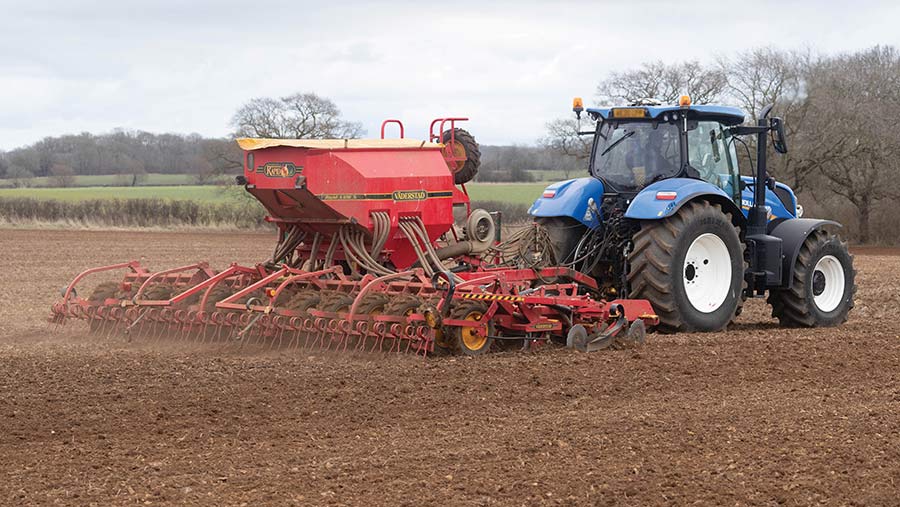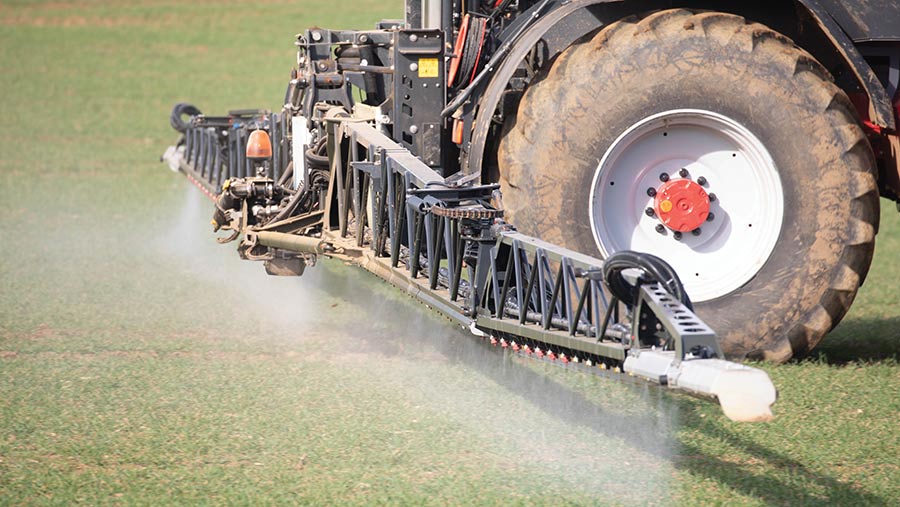Advice on managing blackgrass with wetter, milder winters
 © Tim Scrivener
© Tim Scrivener Climate change is affecting weed control, and while the 2022-23 season was deemed a challenging year, some growers still managed to get good control.
Agrovista technical manager Mark Hemmant points to the bone-dry conditions in late summer that led to virtually no stale seed-bed chits before drilling.
The crops went in in dry conditions, pre-emergence herbicides had suboptimal conditions, and blackgrass tillered well, he recalls.
See also: How to maximise performance of NUM3 legume fallows
But some growers still achieved good levels of control, especially those taking a whole-rotation approach to reduce their seed bank.
“So if you do the right things [to reduce the size of the seed bank] and then get bad weather, you can still get the right results,” Mark says.
Fast-forward to this season and it’s another challenging winter for weed control. So what does this mean for growers in the coming weeks?
Niab weed specialist John Cussans says it is a complex picture with a range of drilling dates, crop conditions and levels of weed pressure.
“It means you can’t generalise with different situations on different farms.”
Therefore, he says farmers will need to take a field-by-field approach this spring. Here are some key pointers to help farmers avoid having a huge grassweed seed return this summer.
1. Is there any point using an ALS-inhibiting herbicide this spring?
John says about 85% of blackgrass seed samples shows resistance to acetolactate synthase (ALS)
inhibiting herbicides, but that means 15% of blackgrass populations are still susceptible.
With Italian ryegrass, nearly 50% are fully susceptible. Add in the handful of bromes with resistance, and 10% of wild oats, and there is a significant chance farmers are missing out on an opportunity to reduce seed return.
He says that there is a mindset that ALS inhibitors don’t work and they are not worth using. This could be one reason why are seeing more bromes, wild oats and ryegrass.
Looking at the testing, one-quarter of those who submitted samples in 2023 ought to be using ALS inhibitors.
John explains that the way we report resistance testing as a rating is designed to flag up any problems with different modes of action early on, rather than provide detailed feedback on the likely level of control once resistance has begun to be detected on-farm.
For example, even where an RR resistance rating is found, you are still getting 75% control and about 60-70% seed reduction.
He points out that testing does not just give a resistance rating.
Farmers will get a percentage mortality figure to indicate what proportion of individuals are still controlled, as well as guidance on the reduction in fresh weight observed after treatment, which is a good estimate of how much an application could reduce seed return.
“We need to be more nuanced when interpreting results,” he says. “You can have a rating of R? or RR resistance and still expect to get a reduction in seed return.”
For those considering testing, he warns that resistance is patchy, so good sampling is important to get a good indication of the population in that field.
And not to just do the odd field but to take a systematic approach across the whole farm.

© Tim Scrivener
Timing
If using an ALS-inhibitor herbicide this spring, it is important to get the timing and application right to maximise efficacy.
Mark says it is important to go in with a post-emergence when weeds are still small, rather than waiting until better weather arrives later in spring.
He recalls work done more than 20 years ago that showed January was the best time to go with herbicides such as Atlantis (iodosulfuron + mesosulfuron) when weeds are still small. “Don’t wait until the T0,” he says.
For Atlantis, ideally apply to a dry or drying leaf and ensure 2-4 hours drying time before dew starts.
With the morning dews, farmer may have quite short windows. It may be just a tank load after lunchtime, so prioritise fields and be ready to act.
Crop safety is also important and is another reason for going earlier. There are more late-sown crops, and if you apply to actively growing crop in spring, there will be more crop effect if left later.
Therefore, going earlier means you are less likely to see a crop effect, especially for late-sown crops.
2. Should I apply a post-emergence herbicide before fertiliser?
Farmers with backward crops will be looking to get their nitrogen on early, but Bayer campaign manager Tom Chillcot says this will also bolster grassweeds.
“Feed the soil and this gives [blackgrass] a competitive advantage, so it is something to bear in mind,” he says.
Farmers should perhaps consider changing the order they do things.
“Maybe they can look to apply the mesosulfuron-based herbicide seven days before applying the first fertiliser dressing to minimise seed return.”
3. How do I manage weeds in spring crops after a wet winter?
Mark says the excessive rain means there will be a bit more compaction and farmers will have to move some soil.
John adds that it is always worse for those bounced into spring cropping, as the area hasn’t been set up and crops are being drilled in suboptimal seed-beds.
“They end up moving more soil, so encouraging greater weed numbers in spring,” he says.
Crop competition could also be lower in these unplanned crops.
Mark says the key thing is to avoid getting it wrong and messing up next season’s crop with a huge seed return. “So there will be a need to use more herbicide.”
He admits this is something farmers don’t want to hear, with gross margins looking squeezed, but they have to think a bit more long-term and avoid being tempted to cut back inputs.
Looking at herbicide options, he suggests considering some Avadex (tri-allate) this spring. Changes to the label mean Avadex Factor (the liquid rather than granular formulation) can now be used on spring wheat.
4. Longer term, is it possible to drill in September?
This winter has highlighted the risk of drilling later, with the weather turning in October, leaving some farmers struggling to get all their wheat crops drilled.
And those who did found that those fields drilled just before the deluge have suffered, with areas rotting off.
Crops drilled earlier have fared better, but early drilling tends to be for those parts of the country with little blackgrass pressure.
However, work by Agrovista is showing that it is possible with what Mark calls “sensible sowing” rather than late drilling.
But it relies on getting the seed bank down. “That includes management in previous seasons to prevent seed return.”
So if farmers do drill earlier, they need to step up other areas of control to compensate.
At its Lamport project in Northamptonshire, Agrovista is looking at direct drilling first wheats in September to determine what farmers need to do it profitably.
Mark says it’s the bits in between the wheat crops that is vital to get right, which includes spring cropping, cover cropping and stale seed-beds to minimise seed return in autumn.
There are other measures including mechanical weeding and using stewardship options such as 2-3 year fallows.
“It’s a whole rotation approach,” he says.
Consequently, Lamport has some nice-looking crops despite the wet winter.

